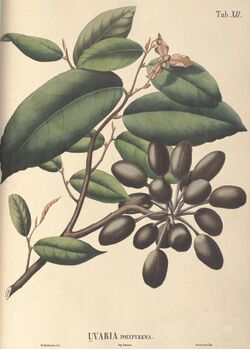Biology:Mitrephora polypyrena
| Mitrephora polypyrena | |
|---|---|

| |
| Color illustration of Mitrephora polypyrena under basionym Uvaria polypyrene.[1] | |
| Scientific classification | |
| Kingdom: | Plantae |
| Clade: | Tracheophytes |
| Clade: | Angiosperms |
| Clade: | Magnoliids |
| Order: | Magnoliales |
| Family: | Annonaceae |
| Genus: | Mitrephora |
| Species: | M. polypyrena
|
| Binomial name | |
| Mitrephora polypyrena (Blume) Zoll.
| |
| Synonyms | |
|
Kinginda macrantha (Hassk.) Kuntze | |
Mitrephora polypyrena is a species of plant in the family Annonaceae. It is native to Java, the Lesser Sunda Islands, and Myanmar.[2] Carl Ludwig Blume, the German botanist who first formally described the species using the basionym Uvaria polypyrena, named it after the many stones or seeds (Latinized forms of Greek πολυ-, poly-, and πυρην, pyren) in its fruit.[3][1]
Description
It is a tree reaching 20 meters in height. Its oval to lance-shaped, leathery leaves are 8-22.5 by 3.5-9 centimeters and come to a point at their tips. The leaves are smooth and shiny on their upper surfaces, while their undersides are slightly hairy. Its petioles are 4.5-11 by 1.5-3.5 millimeters. Its flowers are arranged in groups of 3 or fewer on a rachis. Each flower is on a fleshy, slightly hairy pedicel that is 1.1-1.6 by 20-40 millimeters. The pedicels have an oval, basal bract that is 4-4.5 by 2.5-4.5 millimeters, and another oval, upper bract that is 3.5-5.5 by 4.5-7 millimeters. Its flowers have 3, oval-shaped sepals that are 5-7.5 by 5.5-7.5 millimeters. The outside of the sepals are densely hairy, while their inner surfaces are smooth. Its 6 petals are arranged in two rows of 3. The yellow, oval-shaped outer petals are 24-36 by 18-28 millimeters and come to a point at their tip. The outside surface of the outer petals are densely hairy, while their inner surface is slightly hairy. The inner petals are white with reddish-purple highlights and 17-22 by 9.5-16 millimeters. The outside surface of the inner petals is densely hairy while the tip of the inner surface has long hairs. Its flowers have more than numerous stamen that are 1.5-1.7 by 0.5-0.6 millimeters. Its flowers have up to 24-26 free carpels that are 2-2.2 by 0.5-0.6 millimeters. The carpels have 12-14 ovules. Its fruit occur in clusters of up to 9-12 on pedicels that are 19-34 by 3-5 millimeters and covered in sparse, fine hairs. The round to oblong, smooth fruit are 19-31 by 8-17 millimeters. The fruit have a longitudinal ridge and are sparsely covered in fine brown hairs. The fruit are attached to the pedicel by stipes that are 12-21 by 2.5-4 millimeters and sparsely covered in fine brown hairs. Each fruit has 12-14 seeds that are 15-17 by 8-9.5 millimeters.[4][5]
Reproductive biology
The pollen of M. polypyrena is shed as permanent tetrads.[6]
Habitat and Distribution
It has been observed growing in wet evergreen forests, at elevations of 300 to 700 meters.[5]
Uses
It is used as timber and cultivated as a cover crop and ornamental species.[7]
References
- ↑ 1.0 1.1 Blume, Carl Ludwig (1830) (in Latin). Flora Javae nec non insularum adjacentium. 2. Brussels: J. Frank. pp. 35–37. https://www.biodiversitylibrary.org/item/103181.
- ↑ "Mitrephora polypyrena (Blume) Zoll.". The Trustees of the Royal Botanic Gardens, Kew. n.d.. https://powo.science.kew.org/taxon/urn:lsid:ipni.org:names:74035-1.
- ↑ Stearn, William (2004). Botanical Latin. Portland, Ore. Newton Abbot: Timber Press David & Charles. ISBN 9780881926279.
- ↑ Zollinger, H. (1858). "Ueber die Anonaceen des Ostindischen Archipels" (in German, Latin). Linnaea: Ein Journal für die Botanik in ihrem ganzen Umfange 29: 297–325. https://www.biodiversitylibrary.org/item/10873.
- ↑ 5.0 5.1 Weerasooriya, Aruna D.; Saunders, Richard M. K. (2010). "Monograph of Mitrephora (Annonaceae)". Systematic Botany Monographs 90: 1–167.
- ↑ Walker, James W. (1971). "Pollen Morphology, Phytogeography, and Phylogeny of the Annonaceae". Contributions from the Gray Herbarium of Harvard University 202 (202): 1–130.
- ↑ Nurfadilah, Siti; Hapsari, Lia; Abywijaya, Ilham Kurnia (2017). "Species richness, conservation status, and potential uses of plants in Segara Anakan Area of Sempu Island, East Java, Indonesia". Biodiversitas Journal of Biological Diversity 18 (4): 1568–1588. doi:10.13057/biodiv/d180435.
Wikidata ☰ Q17140121 entry
 |

